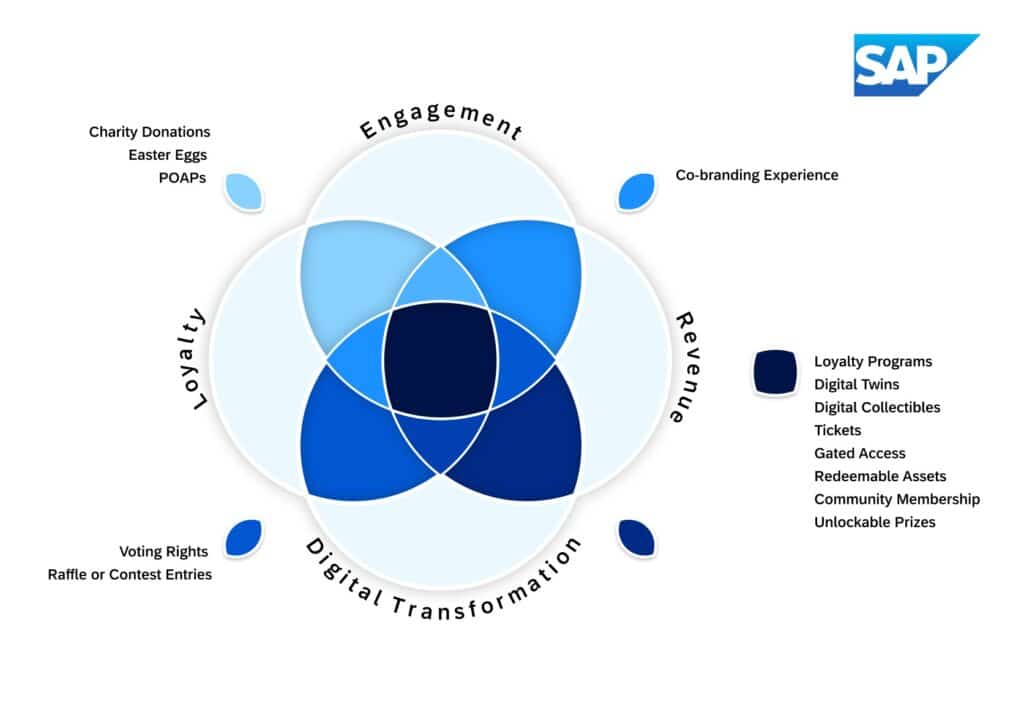Since its founding in 1949, Germany-based coffee and consumer goods retailer Tchibo has always grounded its business model in innovation. From its start as a mail-order distributor of roasted coffee beans, the company has continually pushed the boundaries of new tech, even dipping its stirrer into the burgeoning game console market in 1986.
When Tchibo worked with SAP to develop the NFT Launchpad, it wasn’t simply “stirring the pot.” Tchibo’s innovation-driven DNA and SAP’s 50-year history of tackling business challenges with the best of leading-edge technology was the perfect pairing to help unlock the potential of Web3.
The result was the NFT Launchpad, which allows users to mint, administer, and manage Web3-based non-fungible tokens (NFTs) in a Web2-friendly application. The lighthouse project was capped off by the premier launch of a Tchibo NFT collection dubbed “Tchibo Royalty Club.” Using the NFT Launchpad, Tchibo minted 1,000 unique NFTs on the Polygon blockchain. To get an NFT, collectors entered their e-mail addresses on the Tchibo Royalty Club’s NFT Launchpad page. After receiving a link by e-mail, recipients were able to claim and view their NFTs on the launchpad or transfer them to their digital wallets. “Golden” NFTs were redeemable for prizes like Tchibo coffee cans and Lapressa-branded pens.
I’m so proud of the results and the significance of this collaboration. Because it combines the best functionalities of Web2 and Web3, NFT Launchpad lowers the barriers for companies and collectors alike to get in on the Web3 revolution. For context, the Internet we’ve come to know over the past quarter century is Web2. Web2 technology drove the democratization of the Internet, allowing users to contribute and interact with content. Web3 decentralizes the Internet, making transactions more secure and verifiable by using a distributed blockchain network to validate those transactions. Web3 also allows companies to take advantage of the new digital consumer asset class based on blockchain technology and smart contracts that includes NFTs, tokens, and more.
The project also revealed a compelling array of applications perfectly suited to the rising challenge of meeting customer expectations. Among the most pressing concerns for all retailers today is capturing an ever-fractured share of consumer loyalty. More than ever, engaging customers while remaining profitable increases the urgency for companies to transform the customer experience. Fortunately, the capabilities of Web3 suggest a bounty of use cases.
From loyalty programs to digital twins, NFTs can help increase brand loyalty, engagement, and revenue. Crucially, Web3 can also propel companies on their digital transformations, keeping their brands relevant even for digitally sophisticated Gen Z and Alphas as well as the generations of consumers beyond. As marketing and loyalty tools, NFTs can be issued as brand rewards, promotional or exclusive collectors’ items, and advertising with which younger consumers are likely to engage. Digital twins, for example, are unique ways for companies to engage, interact, and build relationships with audiences.
Digital twins are digital representations of physical objects. NFTs of digital twins, used as promotional items, invitations, passes to special events such as exclusive sales, or redemptions for discounts and physical goods, can be low-cost entries into the Web3 universe. As sales or service tools, digital twins also present excellent possibilities for improving the customer experience post-purchase. Imagine the next time your car’s engine light comes on. Instead of driving it to the repair shop, you share a digital twin that a mechanic can use to virtually investigate and diagnose the problem. You can bet if I’m getting consistently reliable service without leaving my home, I’m a repeat customer.
Internally, companies can also use NFTs as POAPs (Proof of Attendance Protocol) to boost employee engagement. Tchibo has issued POAPs to increase engagement in trainings, while SAP has a similar program that allows in-house tech talk attendees to collect NFTs.
From marketing to commerce to service applications and more, it’s evident that Web3 has great potential to unlock key drivers of success – engagement, revenue, loyalty, and digital transformation – in the new digital landscape.

NFTs as Sustainable Swag
The NFT Launchpad holds a further benefit that speaks to changing consumer and business values. With no production, packaging, or shipping, NFTs can make a claim to sustainability that rises when coupled with the more energy efficient proof-of-stake (PoS) consensus mechanism. POS uses about as much energy as a Google search. Minting an NFT on Polygon, as the team did, uses only one-tenth of the energy required to post a Tweet, amounting to one-forty-four-thousandth of the carbon footprint required to mint an NFT on a proof-of-work (PoW) network.
How proof-of-stake so vastly outperforms proof-of-work in energy efficiency comes down to the way transactions get validated.
- Proof-of-work, used by networks like Bitcoin, involves miners solving complex mathematical problems to validate transactions and create new blocks. This process is energy intensive, requiring a substantial amount of computational power, as every miner in the network performs these computations in a race to mine the block and win the block reward. Once the first miner finishes the computation, all other miners stop processing the block and move on to the next block of transactions. The process repeats itself, using significant amounts of energy in the process.
- Proof-of-stake networks, on the other hand, are more energy-efficient. In PoS, validators are chosen to create new blocks based on the amount of cryptocurrency they hold and are willing to “stake” as collateral, which they lose if other validators determine the block was maliciously processed. Since only a single node in the network creates the block, no complex, energy-intensive, simultaneous processing is performed. PoS consumes significantly less energy than PoW, making it a more sustainable option for blockchain networks.
Further, NFTs have a longer lifespan than physical goods, as they can be stored, transferred, and traded without degradation in quality.
Alpha Release of NFT Management Solution by SAP
This year at SAP Sapphire, SAP introduced its alpha release of the non-fungible token management solution, an enterprise-ready, no-code, software-as-a-service (SaaS) solution for creating, managing, distributing, and claiming Web3 digital assets. Via the solution’s dashboard, companies can create NFT collections and campaigns and administer and distribute NFTs to customers. NFT collection and campaign managers can configure the experience of NFT claimants by customizing benefits linked to NFTs, adding destination links, and more.

I couldn’t be more excited to be testing the alpha release with our partners at Tchibo. I’m also excited to share a preview with you. Scan the QR code to receive a limited edition, custom NFT from the alpha release of the NFT management solution by SAP. NFTs will be distributed to the first 50 people to claim one of these cool, sustainable, custom digital artworks.
With heartfelt thanks to Tchibo, I’m looking forward to our next innovation project. Tchibo’s German slogan, “Jede Woche eine neue Welt” means “Every week is a new world.” It refers to the changing selection of goods, refreshed weekly, in its stores. This sentiment also rings true for business technology, and I’m excited to see what’s next for Tchibo and Web3.
Ritu Bhargava is president and chief operating officer of SAP Industry & Customer Experience.



